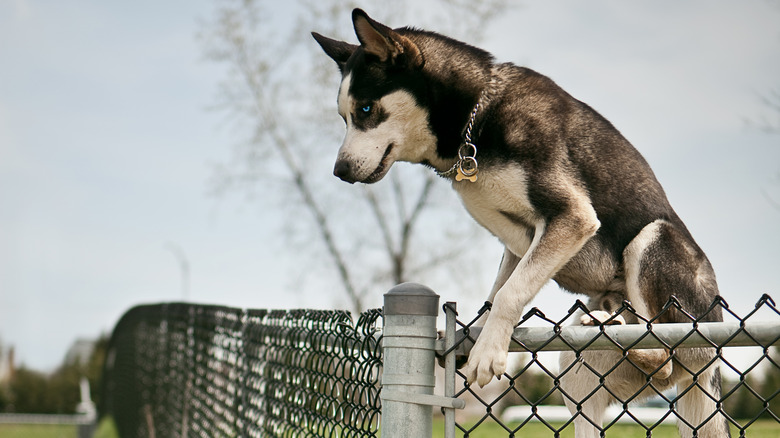How To Protect Your Pets By Creating A Dog-Proof Fence
Sometimes, keeping a dog on the right side of the fence can feel like you're going head-to-head with nature itself. It seems like any time you're not looking, dogs can take on a gaseous state that lets them magically warp through barricades. What can you do when Fido's fence-hopping gets out of control? To create a perfect dog-proof fence, you'll need to factor in fence height, holes, and durability, as well as instinctive animal behaviors.
But a good dog-proof fence isn't just about keeping your pets in, it's also about keeping other animals out. Even if you don't own a dog, not everybody loves the idea of a stray dog digging up flower beds and leaving stinky surprises in their yard. You may want to dog-proof your fence in order to protect other pets like outdoor cats, livestock, or koi fish, or to allow children to play in the backyard without fear of the menacing neighborhood mutt. Whether you want to keep Fido in or out, a solid fence is a great starting place, but there are additional methods of control that can prove to be even more effective. Here's what it takes to create a truly dog-proof fence — both physically and psychologically.
Assess and strengthen your physical barriers
There are only three ways a dog can get in or out of your yard: over, under, or through. If your dog is the problem, start by observing his behavior to see which escape method he prefers. The most common escape route is often the easiest, so unless you have a gaping hole in your fence, make sure that you've closed and locked any backyard gates. Professional landscaper Stormi Weathers told Dogster, "The single most common way I have observed dogs escaping from a yard is when gates are left open or not positively closed." Some dogs are even smart enough to lift the gate latch by themselves, so it's crucial to have a second mode of security in place, like a padlock or carabiner hook and chain.
If your dog isn't going through the gate, he must be going under or over. Most dogs can jump one to three times their shoulder height. To keep large breeds and young dogs from hopping over, a 6-foot fence is usually sufficient, while small breeds only need about 3 to 4 feet. Remember that a chain-link fence is easy to climb, and opt for a slick material like wood, vinyl, or flat bar steel. If you suspect the dog is digging under your fence, try installing no-dig defense barriers around your property, metal grating with spokes that stab deep into the ground.
Look into behavioral solutions
With some dogs, it seems like no matter what you do, they'll try anything to escape. If you're worried about your dog getting out, it's important to get to the root of the issue and invest in some behavioral training. Boredom, separation anxiety, and biological instinct are common reasons why dogs escape. It may help to walk and play with your dog every day, treat anxiety, provide toys, and have your pet spayed or neutered. Positive reinforcement is the best way to rewire your dog's brain and make him want to stay in the yard, but negative reinforcement, like an electric fence, can work as a last resort. Electric fences aren't ideal for long-term results, as your dog may escape if the power fails for even one day.
Unfortunately, there isn't much you can do to train stray neighborhood dogs without their owner's cooperation. In addition to a tall dog-proof fence, you may need to try other methods that will deter them without harming them. Start by removing temptations like trash cans, treats, and attention from you and your family. If you have an unspayed female dog, consider having her fixed, as she could attract males from up to 4 miles away when she's in heat. If removing attractants isn't enough, install a sonic sound machine to repel dogs, spray vinegar on gardens, talk with your neighbors, and, if necessary, call animal control to keep yourself, your pets, and your family safe.


